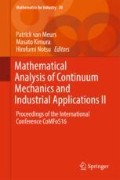Abstract
This paper introduces the recent developments in the earthquake rupture simulations particularly focusing on our applications of the spatiotemporal domain boundary integral equation method (ST-BIEM) and the fast domain partitioning method (FDPM), which enable us to reduce the required memory storage and the computation time, respectively, to \(O(M^{2})\) and \(O(MN^{2})\) from the original values of \(O(M^{2}N)\) and \(O(MN^{3})\) for the given elements M and time steps N. FDPM utilizes the particular spatiotemporal dependence of the stress Green’s function (fundamental solutions) by partitioning the causality cone. FDPM can also seamlessly combine fully dynamic and quasi-dynamic simulation algorithms adapted in seismology. Related issues in seismological simulations are also discussed.
Access this chapter
Tax calculation will be finalised at checkout
Purchases are for personal use only
References
Aki, K., Richards, P.G.: Quantitative Seismology, 2nd edn. University Science Books (2002)
Ando, R.: Fast Domain Partitioning Method for dynamic boundary integral equations applicable to non-planar faults dipping in 3-D elastic half-space. Geophys. J. Int. 207, 833–847 (2016)
Ando, R., Okuyama, S.: Deep roots of upper plate faults and earthquake generation illuminated by volcanism. Geophys. Res. Lett. 37 (2010)
Ando, R., Yamashita, T.: Effects of mesoscopic-scale fault structure on dynamic earthquake ruptures: dynamic formation of geometrical complexity of earthquake faults. J. Geophys. Res. 112 (2007). https://doi.org/10.1029/2006JB004612
Ando, R., Kame, N., Yamashita, T.: An efficient boundary integral equation method applicable to the analysis of non-planar fault dynamics. Earth Planets Space 59, 363–373 (2007)
Ando, R., Shaw, B.E., Scholz, C.H.: Quantifying natural fault geometry: statistics of splay fault angles. Bull. Seismol. Soc. Am. 99, 389–395 (2009)
Andrews, D.J.: Rupture velocity of plane strain shear cracks. J. Geophys. Res. 81, 5679–5687 (1976)
Aochi, H., Fukuyama, E.: Three-dimensional nonplanar simulation of the 1992 landers earthquake. J. Geophys. Res. 2002107 (1992). https://doi.org/10.1029/2000JB000061
Brudy, M., Zoback, M.D., Fuchs, K., Rummel, F., Baumgartner, J.: Estimation of the complete stress tensor to 8 km depth in the KTB scientific drill holes: Implications for crustal strength. J. Geophys. Res. 102, 18453–18475 (1997)
Chen, X.F., Zhang, H.M.: Modelling rupture dynamics of a planar fault in 3-D half space by boundary integral equation method: an overview. Pure Appl. Geophys. 163, 267–299 (2006)
Cochard, A., Madariaga, R.: Dynamic faulting under rate-dependent friction. Pure Appl. Geophys. 142, 419–445 (1994)
Fukuyama, E., Madariaga, R.: Rupture dynamics of a planar fault in a 3D elastic medium: rate- and slip-weakening friction. Bull. Seismol. Soc. Am. 88, 1–17 (1998)
Hackbusch, W.: A sparse matrix arithmetic based on H-matrices. part I: introduction to H-matrices. Computing 62, 89–108 (1999)
Hardebeck, J.L., Michael, A.J.: Stress orientations at intermediate angles to the San Andreas Fault, California. J. Geophys. Res. 109 (2004)
Ida, Y.: Cohesive force across the tip of a longitudinal-shear crack and Griffith’s specific surface energy. J. Geophys. Res. 77, 3796–3805 (1972)
Ide, S., Takeo, M.: Determination of constitutive relations of fault slip based on seismic wave analysis. J. Geophys. Res. 102, 27379–27391 (1997)
Kame, N., Kusakabe, T.: Proposal of extended boundary integral equation method for rupture dynamics interacting with medium interfaces. J. Appl. Mech. Trans. ASME 79 (2012)
Kanamori, H., Anderson, D.L.: Theoretical basis of some empirical relations in seismology. Bull. Seismol. Soc. Am. 65, 1073–1095 (1975)
Koller, M.G., Bonnet, M., Madariaga, R.: Modeling of dynamic crack-propagation using time-domain boundary integral-equations. Wave Motion 16, 339–366 (1992)
Lapusta, N., Liu, Y.: Three-dimensional boundary integral modeling of spontaneous earthquake sequences and a seismic slip. J. Geophys. Res. 114 (2009)
Lapusta, N., Rice, J.R., Ben-Zion, Y., Zheng, G.T.: Elastodynamic analysis for slow tectonic loading with spontaneous rupture episodes on faults with rate- and state-dependent friction. J. Geophys. Res. 105, 23765–23789 (2000)
Matsumoto, S. et al.: Spatial heterogeneities in tectonic stress in Kyushu, Japan and their relation to a major shear zone. Earth Planets Space 67 (2015)
Michael, A.J.: Use of focal mechanisms to determine stress - a control study. J. Geophys. Res. 92, 357–368 (1987)
Nishimura, N.: Fast multipole accelerated boundary integral equation methods. Appl. Mech. Rev. 55, 299–324 (2002)
Noda, H., Nakatani, M., Hori, T.: A slower fault may produce a smaller preseismic moment rate: non-1/t(f) acceleration of moment rate during nucleation and dependency on the background slip rate. Geophys. Res. Lett. 40, 4850–4854 (2013)
Ohtani, M., et al.: Fast computation of quasi-dynamic earthquake cycle simulation with hierarchical matrices. Procedia Comput. Sci. 4, 1456–1465 (2011)
Scholz, C.H.: Earthquakes and friction laws. Nature 391, 37–42 (1998)
Scholz, C.H.: The Mechanics of Earthquakes and Faulting, 2nd edn. Cambridge University Press, Cambridge (2002)
Tada, T.: Displacement and stress Green’s functions for a constant slip-rate on a quadrantal fault. Geophys. J. Int. 162, 1007–1023 (2005)
Tada, T.: Stress Green’s functions for a constant slip rate on a triangular fault. Geophys. J. Int. 164, 653–669 (2006)
Tada, T., Madariaga, R.: Dynamic modelling of the flat 2-D crack by a semi-analytic BIEM scheme. Int. J. Numer. Methods Eng. 50, 227–251 (2001)
Tada, T., Yamashita, T.: Non-hypersingular boundary integral equations for two-dimensional non-planar crack analysis. Geophys. J. Int. 130, 269–282 (1997)
Tse, S.T., Rice, J.R.: Crustal earthquake instability in relation to the depth variation of frictional slip properties. J. Geophys. Res. 91, 9452–9472 (1986)
Yoshikawa, H., Nishimura, N.: A study on the reduction of the memory requirements and the computational time for elastodynamic TD-BIEM using the temporal linearity of the fundamental solution. Trans. Jpn. Soc. Comp. Met. Eng. 9 (2009) No. 16-091211
Acknowledgements
This study is supported in part by JSPS/MEXT KAKENHI Grant Numbers JP25800253 and JP26109007.
Author information
Authors and Affiliations
Corresponding author
Editor information
Editors and Affiliations
Rights and permissions
Copyright information
© 2018 Springer Nature Singapore Pte Ltd.
About this paper
Cite this paper
Ando, R. (2018). On Applications of Fast Domain Partitioning Method to Earthquake Simulations with Spatiotemporal Boundary Integral Equation Method. In: van Meurs, P., Kimura, M., Notsu, H. (eds) Mathematical Analysis of Continuum Mechanics and Industrial Applications II. CoMFoS 2016. Mathematics for Industry, vol 30. Springer, Singapore. https://doi.org/10.1007/978-981-10-6283-4_8
Download citation
DOI: https://doi.org/10.1007/978-981-10-6283-4_8
Published:
Publisher Name: Springer, Singapore
Print ISBN: 978-981-10-6282-7
Online ISBN: 978-981-10-6283-4
eBook Packages: EngineeringEngineering (R0)

